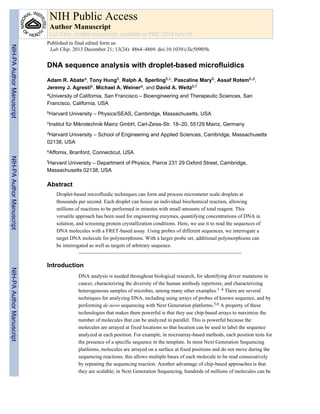This document describes a droplet-based microfluidic system for analyzing DNA sequences using fluorescence resonance energy transfer (FRET). DNA probes labeled with FRET dye pairs are encapsulated in microdroplets along with fluorescent labeling dyes. A picoinjection device is used to introduce DNA templates into the droplets for ligation reactions with the probes. By measuring FRET and dye fluorescence, the system can determine if probe sequences match the template. This allows high-throughput DNA sequence analysis using only small amounts of reagents.






![our system could be used for targets of arbitrary, unknown sequence, forming the basis for a
fast and low-cost DNA sequencing platform.
Acknowledgments
This work was supported by the National Science Foundation (NSF) (DMR-1006546), the National Institutes of
Health (NIH) (P01GM096971 and 5R01EB014703-02), the Harvard Materials Science Research and Engineering
Center (DMR-0820484). R. A. S. gratefully acknowledges financial support from German Research Foundation
(grant SP1282/1-1).
References
1. Stratton MR, Campbell PJ, Futreal PA. Nature. 2009; 458(7239):719–724. [PubMed: 19360079]
2. Tomlinson IM, Walter G, Marks JD, Llewelyn MB, Winter G. J Mol Biol. 1992; 227(3):776–798.
[PubMed: 1404388]
3. de Wildt RMT, Hoet RMA, van Venrooij WJ, Tomlinson IM, Winter G. J Mol Biol. 1999; 285(3):
895–901. [PubMed: 9887257]
4. Tringe SG, von Mering C, Kobayashi A, Salamov AA, Chen K, Chang HW, Podar M, Short JM,
Mathur EJ, Detter JC, Bork P, Hugenholtz P, Rubin EM. Science. 2005; 308(5721):554–557.
[PubMed: 15845853]
5. Heller MJ. Annu Rev Biomed Eng. 2002; 4:129–153. [PubMed: 12117754]
6. Shendure J, Ji HL. Nat Biotechnol. 2008; 26(10):1135–1145. [PubMed: 18846087]
7. Beebe DJ, Mensing GA, Walker GM. Annu Rev Biomed Eng. 2002; 4:261–286. [PubMed:
12117759]
8. Squires TM, Quake SR. Rev Mod Phys. 2005; 77(3):977–1026.
9. Whitesides GM. Nature. 2006; 442(7101):368–373. [PubMed: 16871203]
10. Teh SY, Lin R, Hung LH, Lee AP. Lab Chip. 2008; 8(2):198–220. [PubMed: 18231657]
11. Guo MT, Rotem A, Heyman JA, Weitz DA. Lab Chip. 2012; 12(12):2146–2155. [PubMed:
22318506]
12. Tran TM, Lan F, Thompson CS, Abate AR. J Phys D: Appl Phys. 2013; 46:114004.
13. Zheng B, Roach LS, Ismagilov RF. J Am Chem Soc. 2003; 125(37):11170–11171. [PubMed:
16220918]
14. Song H, Chen DL, Ismagilov RF. Angew Chem, Int Ed. 2006; 45(44):7336–7356.
15. Huebner A, Srisa-Art M, Holt D, Abell C, Hollfelder F, Demello AJ, Edel JB. Chem Commun.
2007; 12:1218–1220.
16. Brouzes E, Medkova M, Savenelli N, Marran D, Twardowski M, Hutchison JB, Rothberg JM,
Link DR, Perrimon N, Samuels ML. Proc Natl Acad Sci U S A. 2009; 106(34):14195–14200.
[PubMed: 19617544]
17. Mazutis L, Araghi AF, Miller OJ, Baret JC, Frenz L, Janoshazi A, Taly V, Miller BJ, Hutchison
JB, Link D, Griffiths AD, Ryckelynck M. Anal Chem. 2009; 81(12):4813–4821. [PubMed:
19518143]
18. Eastburn DJ, Sciambi A, Abate AR. Anal Chem. 2013; 85(16):8016–8021. [PubMed: 23885761]
19. Xia YN, Whitesides GM. Angew Chem, Int Ed. 1998; 37(5):551–575.
20. Anna SL, Bontoux N, Stone HA. Appl Phys Lett. 2003; 82(3):364–366.
21. Abate AR, Hung T, Mary P, Agresti JJ, Weitz DA. Proc Natl Acad Sci U S A. 2010; 107(45):
19163–19166. [PubMed: 20962271]
22. O’Donovan B, Eastburn DJ, Abate AR. Lab Chip. 2012; 12(20):4029–4032. [PubMed: 22930333]
23. Eastburn DJ, Sciambi A, Abate AR. PLoS One. 2013; 8(4):e62961. [PubMed: 23658657]
24. Sjostrom SL, Joensson HN, Svahn HA. Lab Chip. 2013; 13(9):1754–1761. [PubMed: 23478908]
Abate et al. Page 7
Lab Chip. Author manuscript; available in PMC 2014 July 10.
NIH-PAAuthorManuscriptNIH-PAAuthorManuscriptNIH-PAAuthorManuscript](https://image.slidesharecdn.com/5f2c676d-88a4-499b-a11b-8d9392a48511-160607150236/85/LabOnAChip-13_4864-7-320.jpg)





